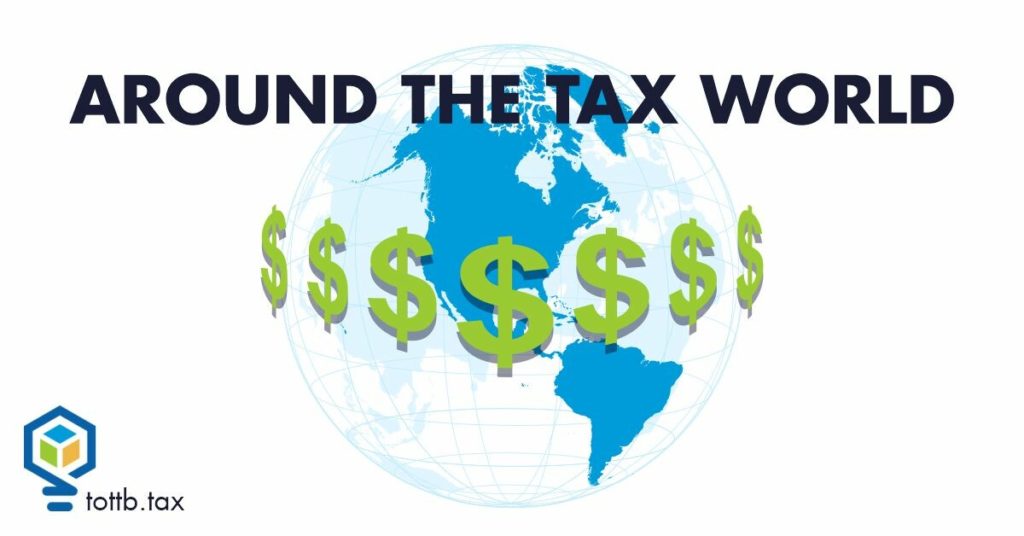
At Around the Tax World, you can find out all about what’s going on in the wonderful, worldwide world of tax. Every month, we’ll feature a few mini-articles on what’s been going on in the world when it comes to tax, and fully available for viewing even if you don’t have a subscription.
If you wish to subscribe and gain access to all articles on the site, be sure to check out the benefits of doing so here!
Check out what’s happening all around the world of tax!
WORLD NEWS
Tesla’s lowest-price vehicle may soon lose eligibility for the EV tax credit… as new eligibility guidelines are released from the IRS this month. Tesla’s standard-range Model 3 has an LFP battery that is manufactured in China, which may make it ineligible for the $7,500 federal tax credit beginning in April. The Inflation Reduction Act introduced this tax break, in part, to encourage automakers to source materials and assemble their vehicles in the U.S. or via U.S. trade partners. Tesla’s other Model 3 and their Model Y vehicles are expected to remain eligible for the full $7,500, since their battery cells are built in the U.S.
UK Prime Minister Rishi Sunak released a summary of his personal tax records… which show that Sunak has earned almost 5 million pounds within the past three years. While about £410,000 of Sunak’s earnings came from his ministerial salary, the bulk of it came from interest, dividends, and capital gains on his U.S. investment fund. The prime minister paid an effective tax rate of 22% during these years, totaling about 1 million pounds. Critics observed that Sunak’s low tax rate reveals a problem with the UK’s tax system, which levies capital gains at a much lower rate than income.
U.S. NEWS
The U.S. Treasury is set to publish updated guidance for the EV tax credit before the end of March
Since the introduction of the Inflation Reduction Act, many electric vehicles have been eligible for up to $7,500 in tax incentives, but new rules around battery-sourcing requirements are expected to reduce the number of vehicles that qualify for the credit. The EV industry has been grappling with concerns about the lack of clear guidelines and trying to predict whether major changes will be necessary to ensure their vehicles meet the requirements—and therefore appeal to buyers looking for a tax break. The Treasury initially indicated this guidance would be available in 2022 but moved the date to March 2023. During this time, the agency left the old rules in place, causing automakers to urge consumers to make their purchases before more restrictive rules could be enforced.
The expected changes center on one of the main goals of the Inflation Reduction Act—to increase reliance on EV materials sourced within the U.S. and decrease reliance on imported materials from countries like China. To be eligible for the tax credit, automakers must source a certain percentage of the materials used in their batteries either in North America or in a country that has a free-trade agreement with the U.S. The percentage required is set to gradually increase over time. Additionally, the battery components must be manufactured in North America. These are the topics that auto manufacturers and consumers alike are anticipating in the upcoming Treasury guidance.
The Treasury is also expected to release guidance around clean energy incentives in the coming months, including information on tax breaks for energy-efficient home appliances, manufacturing of clean energy technology, sustainable aviation fuels, and other energy sources. The new laws also extend existing renewable energy credits and allows nonprofits and government agencies to receive financial energy-related incentives even though they do not pay taxes. In total, the climate and energy provisions compose about $270 billion of the $369 billion spent through the Inflation Reduction Act.
STATE NEWS
Texas advances a new $16.5 billion proposal that includes property tax cuts… and increased funding for public schools. The Texas Senate voted unanimously in favor of three bills that would use part of the state’s $33 billion surplus to raise the homestead exemption and reduce business property taxes.
The first bill passed would change the homestead exemption for school districts and increase the portion of a home’s value that is tax-exempt—from $40,000 up to $70,000, with an additional $20,000 exemption for seniors. Homeowners who pay the average school tax rate would save $341 on their annual tax bill, and seniors would save an additional $227.
The second bill funnels $5.38 billion into public schools, which are largely funded by state property taxes. To offset this cost, the bill also cuts school property tax rates by 7 cents per every $100 in property value. Though Democrats expressed concerns over reducing the revenue stream for schools, since much of the current budget surplus is a result of unique pandemic-related circumstances, the Senate ultimately voted in favor of this measure.
Lastly, the third bill to make it through the Senate would cut business property taxes by $1.5 billion if approved by the House.
Montana has introduced new income and property tax rebates… backed by Governor Greg Gianforte. The individual income tax rebates are funded by $480 million in surplus state revenue. This amounts to $1250 for single filers and $2500 for married couples filing jointly. Rebates will be remitted automatically starting this July to eligible households who paid taxes in 2021.
The property tax rebate refunds up to $500 a year on 2022 and 2023 property taxes for a principal residence. Surplus state revenue also provided the funding for this initiative, which will cost the state an estimated $280 million. This rebate requires taxpayers to apply online through the TransAction Portal or via mail. Applications for the 2022 tax year can be submitted starting on August 15, 2023, and the deadline to file a claim is October 1, 2023. For the 2023 tax year, applications will be accepted starting on August 15, 2024.
For more information on the recently passed bills, taxpayers can visit the 2023 Montana Tax Rebates website.
TAX PLANNING
Student loan borrowers may see fewer deductions in the 2023 tax season. While the Supreme Court continues assessing the legitimacy of the Biden administration’s student debt cancellation plan, student loan borrowers turn to the task of filing their tax returns. Before the COVID-19 pandemic, taxpayers could leverage the student loan interest deduction to deduct up to $2500 on loan interest payments. To be eligible, taxpayers must be legally required to pay interest and must be below the income threshold for that year. They also cannot have a filing status of married filing separately and cannot be claimed as dependents on someone else’s tax return.
However, since the U.S. Department of Education has allowed most borrowers to pause their loan repayments, this also means that taxpayers are not making interest payments and therefore are not eligible for the deduction for that tax year. Even payments made within the past few years will not likely qualify for the full deduction because the payments are going toward the principal debt, not the interest.
If you are uncertain whether you have eligible interest payments, you can refer to your 1098-E form, which your lender must submit to the IRS to report interest payments over a certain amount. You can also connect with a tax professional, such as a Certified Tax Planner, to better understand how educational expenses can factor into your tax plan.
With this year’s tax deadline approaching, the IRS draws taxpayers’ attention to these key reminders. Before April 18th comes around, taxpayers would be wise to review the IRS’ list of common errors to avoid delays in processing or receiving any tax refunds.
- Start by gathering all relevant documents—from the typical W-2 and 1099 forms to supporting documentation for tax deductions and credits.
- Filing electronically and opting for direct deposit is also recommended to reduce math errors and help identify potential tax credits or deductions.
- Select the appropriate filing status. Use the IRS’ Interactive Tax Assistant for help if more than one filing status could apply.
- Double-check basic details like your name, birth date, and Social Security number. Remember to enter the information for any of your dependents exactly as it appears on their Social Security card.
- Be sure to answer the digital assets question. Leaving this field blank will only result in processing delays.
- Remember to report all taxable income to avoid penalties and interest.
Lastly, if you are struggling to get your tax return completed by April 18th, you can also file for a six-month extension to October 16th using Form 4868.
NOT A MEMBER YET?

SUBSCRIBE TO GET ALL OF OUR
GREAT ARTICLES AND RESOURCES!
CURRENT EDITION

Summertime Marketing in Your Tax & Accounting Firm
Tax season is prosperous, summer is dry until extension season. Do you find yourself in that cycle? Clients are “easy” to get during tax season when taxes are top of mind. Then the direct deposits go dry by June, and you are looking for what’s next. Stop the search, you don’t have to add another service. You need better marketing to highlight the service that you offer and specialize in. This will allow you to have a predictable client pipeline. You can do tax preparation, planning, and or representation all year long.

Observations on the House-Passed OBBB
This article focuses on the OBBB from the House offering a variety of observations to help understand the range of changes, relevance to compliance and planning, process considerations and some unexpected provisions. While the final OBBB will not include all of the House provisions or will modify some of them, there are lessons to learn to understand the tax legislation process and results now and in the future.

Client Retention as a Prospecting Strategy: Turning Current Clients into Referral Sources
In the competitive accounting world, where trust and reliability are paramount, client retention is not just a success metric—it’s a vital strategy for sustainable growth. For Certified Public Accountants (CPAs), accountants, and bookkeepers, maintaining a solid relationship with existing clients can unlock new business opportunities, turning satisfied clients into powerful referral sources.

